
The Ultimate Guide to the Evolution of Microservices
- Dishit Devasia
- Technology , Data
- April 28, 2025
When software engineers talk about microservices, most do not understand the context in which the architecture originated. This leads to “doing microservices” instead of solving business problems. The assumption here is that microservices are the silver bullet for solving business problems.
Ready for a Challenge?
But there are no silver bullets, as Frederick P. Brooks Jr. discussed in his famous 1986 paper, “NO SILVER BULLET — ESSENCE AND ACCIDENTS OF SOFTWARE ENGINEERING.” When you move to doing microservices, you are only increasing the accidental complexity that Brooks mentions in his paper.
So, how can you know if you are not introducing accidental complexity when building a microservices architecture? To understand this, you need to go back to the evolution of software architecture.
The Beginning
In the beginning, there was the computer. A massive, room-filling machine with thousands of vacuum tubes and transistors, requiring an entire team of engineers to keep it running. In the 1950s, these behemoths — like the UNIVAC I and IBM 701 — were the pinnacle of computing, and businesses lined up to access their raw power.
If you needed to do some processing, you didn’t just log in — you walked into a computer room, handed your punch cards to an operator, and waited. Computing was centralized. Expensive. Slow.
As Moore’s law took effect, computers started getting smaller and faster, but they remained expensive. Therefore, people needed to share their computing resources.
This led to the Client-Server architecture.
Client-Server Architecture
This shift led to the client-server architecture, in which a central server handled business logic, and users accessed it through individual client machines.
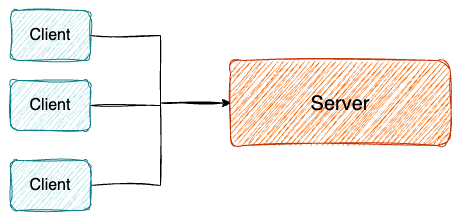
Companies like IBM, Sun Microsystems, and Microsoft built entire ecosystems around this model, creating the foundation for modern business applications.
Now, in software engineering, we solve problems, only to find that the problems get bigger.
The client-server model worked well in the early days but had limitations.
You had desktop applications that connected to a server. The tight coupling meant that any change in business logic meant a change on the server, and all the clients needed to be upgraded.
Then the internet arrived.
The Rise of 3-Tier Architecture (1990s–Early 2000s)
Now, you only need a browser that needs to connect to a server. The users do not need to have clients to get access to the server. The browser with HTML was enough to get work done.
What that meant was that the processing complexity increased on the server.
To cater to increased complexity on the server side, engineers developed the 3-tier architecture.
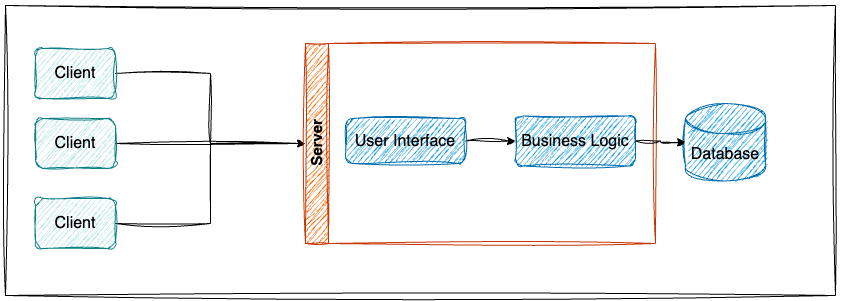
The server side was decomposed into three tiers:
- User interface — what users will be able to see
- Business layer — where all the business logic resides, like how to calculate an employee’s salary based on leaves, designation, role
- Database layer — where all the information was stored, such as name, designation, role
This design sowed the seeds of the monolithic architecture that is now seen as an anti-pattern by many junior engineers.
Monolithic Architecture
A monolith is a system in which all components (UI, business logic, database) are tightly coupled and deployed as one unit.
Example: A flight booking website built as a monolith:
- A user interface to search for flights
- A booking module to reserve seats
- A payment module to process transactions
- A notification system to send emails
All these components exist in one codebase, one database, and one deployment unit.
Benefits
- Easy to start with for small teams
- One unit of deployment
- Simpler deployment process
- Straightforward transaction management
- Lower operational overhead
Challenges
- As application size increases, the deployment time increases
- To scale, you need to use vertical scaling even if only certain application parts might require more CPU/memory
- A bug in any layer would need full deployment of the entire package
- Things can get messy quickly, as each new business functionality means re-wiring the logic
- Team coordination becomes more difficult as the organization grows
Modular Monolith
A modular monolith is a monolithic application structured into separate, well-defined modules with clear boundaries. However, it is still deployed as a single unit.
Example: Flight booking website modules:
- Flight Search Module
- Booking Module
- Payment Module
- Notifications Module
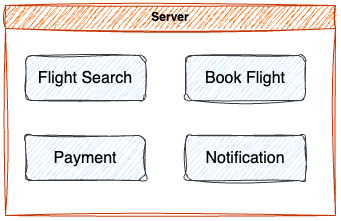
Benefits
This architecture offsets some of the challenges of raw monolithic applications. Here we are moving towards creating modules based on business functions.
- The code is better organized and easier to maintain
- Setting up mocks, stubs, or running multiple services is not required as the entire application is one unit
- When a series of operations need to be performed as a single unit (i.e., a transaction), monoliths are easier to manage
- Since operational complexity is low, the cost of running a monolith is often lower than running multiple services (for lower volumes)
- Teams can work more independently within their module boundaries
Challenges
The challenges of scaling and deployment remained. But enterprises found a different problem.
Enterprise organizations found that they have multiple modular monoliths, and the business requires them to talk to each other.
You had multiple monoliths trying to talk to each other. These applications could be on different technologies. Any change in one application meant all the interfaces with which it interacted needed to be tested for regression impacts.
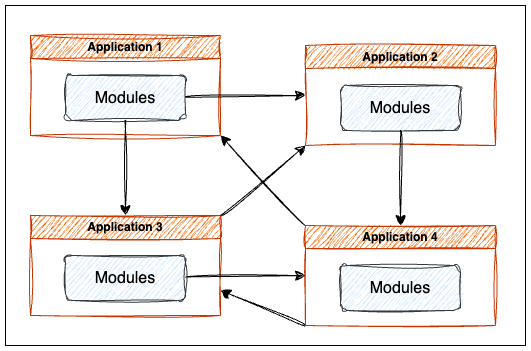
When to Use a Modular Monolith
- When you want a structured codebase without the complexity of microservices
- When the team is small but growing
- For startups that know their key features and can work their way up from there
- When your domain boundaries are still evolving
- When operational simplicity is more valuable than fine-grained scaling
Service Oriented Architecture (SOA)
Service-Oriented Architecture (SOA) is an architectural style that supports service orientation. Service orientation is a way of thinking in terms of services and service-based development and the outcomes of services. A service:
- Is a logical representation of a repeatable business activity that has a specified outcome (e.g. check customer credit; provide weather data, consolidate drilling reports)
- Is self-contained
- May be composed of other services
- Is a “black box” to consumers of the service
The SOA architectural style has the following distinctive features:
- It is based on the design of the services — which mirror real-world business activities — comprising the enterprise (or inter-enterprise) business processes.
- Service representation utilizes business descriptions to provide context (i.e., business process, goal, rule, policy, service interface, and service component) and implements services using service orchestration.
- It places unique requirements on the infrastructure — it is recommended that implementations use open standards to realize interoperability and location transparency.
- Implementations are environment-specific — they are constrained or enabled by context and must be described within that context.
- It requires strong governance of service representation and implementation.
- It requires a “Litmus Test”, which determines a “good service”.
Definition from The Open Group
This was the first attempt to move towards business functionality as services.
The idea was to have coarse-grained services, such as an entire business process, handled by a service. Most SOA implementations deployed an Enterprise Service Bus (ESB), facilitating communication between services.
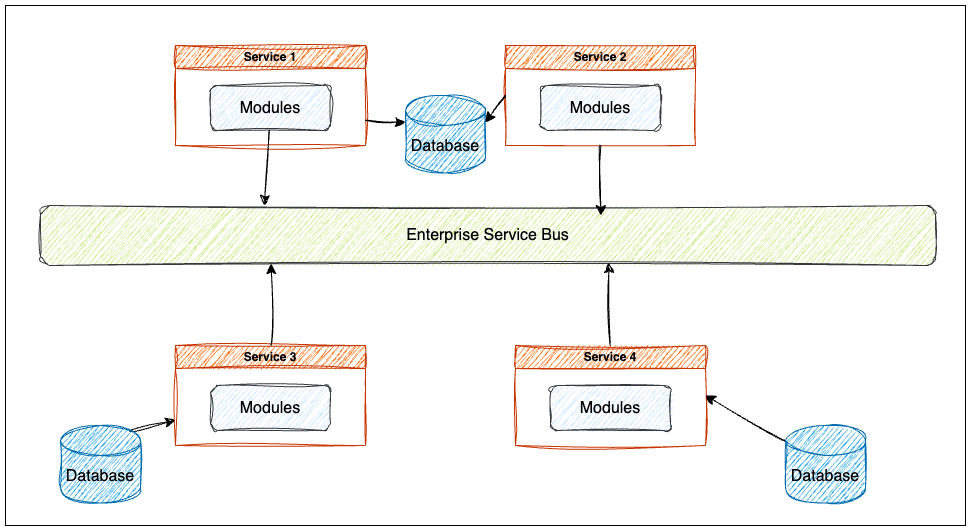
When SOA was introduced, most organizations followed the waterfall methodology of software development, and deploying all applications as a single deployment was still the norm.
The other aspect was that container technology was either non-existent or not mature enough for engineers to consider deploying smaller services.
Services are coarse-grained and share a standard communication protocol (e.g., SOAP).
Benefits:
- Standardization: ESB simplifies governance and message routing
- Reusability: Services can be reused across multiple applications
- Technology agnostic: Services can be implemented in different technologies
- Business-IT alignment: Services map to business capabilities
Disadvantages:
- ESB can become a single point of failure
- Although ESB was intended to simplify application interfaces, the challenge of deploying ESB with multiple interface changes remained
- Heavy governance requirements
- Often led to complex, heavyweight implementations
Microservices
Microservices architecture is an approach in which an application is broken down into small, independently deployable services that communicate via APIs.
The term “Microservice Architecture” has sprung up over the last few years to describe a particular way of designing software applications as suites of independently deployable services. While there is no precise definition of this architectural style, there are certain common characteristics around organization around business capability, automated deployment, intelligence in the endpoints, and decentralized control of languages and data. — Martin Fowler, 2014
As the name suggests, microservices are more finely-grained services than services defined as part of SOA architecture.
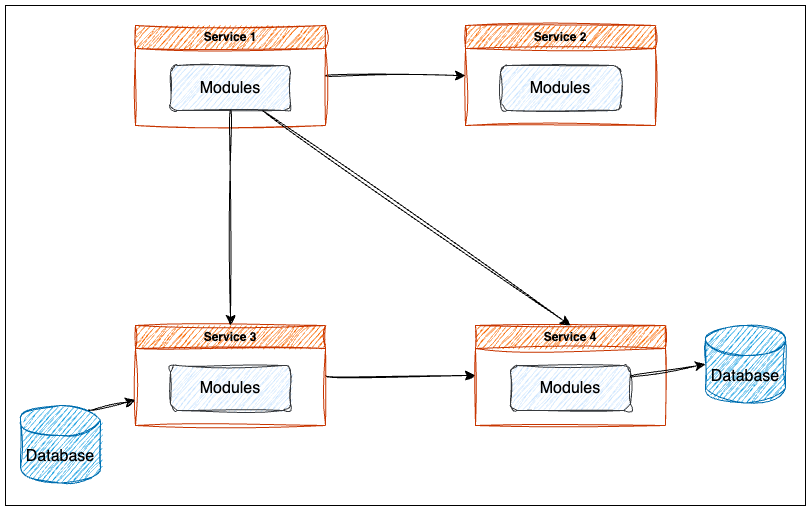
Example: Microservices-Based Flight Booking System
Each function runs as an independent microservice:
- Search Service
- Booking Service
- Payment Service
- Notification Service
Benefits
- Independent Scaling: Each service can be independently scaled depending on the volume requirements. For example, you have high search volume but low payment volume. If you only want to handle volumes related to search functionality, you can increase the containers handling just the search functionality.
- Smaller Builds: Build times are faster as the services are smaller. This leads to higher developer productivity.
- Independent Deployment: Each service is independent of others, so services can be deployed separately. Feature toggles and different approaches ensure you can deploy without affecting existing functionality.
- Technology Flexibility: Teams can choose the best technology stack for their specific service requirements.
- Team Autonomy: Teams can own and operate their services independently.
- Fault Isolation: A failure in one service doesn’t necessarily bring down the entire system.
- Smart endpoint and dumb pipes: The challenge with ESB was that the business logic started residing within ESB, and the owners of ESB had to be across all the business, which makes it a tough proposition. Microservices require inter-service communication on a light-weight protocol such as HTTP without context. The services are smart enough to process the requests and business knowledge remains within the service, making it easier to maintain.
Challenges
- Increased Operational Complexity: Deploying each microservice means having different deployment pipelines. Each service is an infrastructure component, which increases the accidental complexity of maintaining services in production. This includes alerting, security, monitoring, and logging.
- Distributed System Challenges: Microservices introduce all the complexities of distributed systems, including network latency, message serialization, and unreliable networks.
- Data Management: Maintaining data consistency across services is challenging.
- Testing Complexity: Integration and end-to-end testing become more complex.
- Service Discovery: Services need to find and communicate with each other.
- Team Overhead: This can be overwhelming for smaller teams, as most time might be spent on engineering work rather than building features.
Domain-Driven Design and Microservices
Domain-Driven Design (DDD) provides crucial concepts for effective microservice architecture:
Bounded Contexts
A bounded context is a specific responsibility with explicit boundaries that separate it from other system parts. In microservices, each service typically represents a bounded context.Ubiquitous Language
Each bounded context has its own ubiquitous language—terms and definitions specific to that context. This helps define clear service boundaries.Aggregates
Aggregates are clusters of domain objects that should be treated as a single unit. In microservices, aggregates often help define data ownership boundaries.
Implementing microservices without understanding DDD principles often leads to poorly defined service boundaries, resulting in tight coupling and distributed monoliths.
Case Studies
Netflix: Successful Microservices Adoption
Netflix began its journey to microservices in 2008, moving from a monolithic DVD rental application to a cloud-based streaming service composed of hundreds of microservices.
Key Factors in Success:
- Gradual migration
- Strong DevOps culture
- Investment in tooling and infrastructure
- Building for failure with techniques like Chaos Monkey
- Team autonomy with centralized governance
Results:
- Ability to scale to millions of users globally
- Faster feature development and deployment
- Improved system resilience
Segment: The Move Back from Microservices
Segment initially embraced microservices enthusiastically but later consolidated back to a more monolithic approach for their data pipeline.
Challenges They Faced:
- Operational complexity exceeded team capacity
- Development velocity decreased due to cross-service dependencies
- Testing and debugging became increasingly difficult
Key Takeaway: Microservices are not always the right solution, even for companies with technical expertise. Business needs must justify the complexity trade-off.
Data Management in Microservices
Distributed Data Challenges
- Data Ownership: Each service should ideally own its data
- Consistency: Maintaining consistency across services requires careful design
- Query Complexity: Joining data across services is challenging
Common Patterns
- Database per Service: Each microservice has its own database
- Event Sourcing: Using events as the source of truth
- CQRS (Command Query Responsibility Segregation): Separating read and write operations
- Saga Pattern: Managing distributed transactions across services
- Event-Driven Architecture: Services rely on events to achieve eventual consistency
Infrastructure Requirements for Microservices
Successful microservices implementation requires significant infrastructure:
- Container Orchestration: Kubernetes, Docker Swarm
- Service Discovery: Consul, Eureka
- API Gateway: Kong, AWS API Gateway
- Monitoring & Observability: Prometheus, Grafana, Jaeger
- CI/CD Pipelines: Jenkins, GitHub Actions, CircleCI
- Configuration Management: Spring Cloud Config, Consul
Organizations must be prepared to invest in these technologies and the expertise to use them effectively.
Conway’s Law and Organizational Structure
Conway’s Law states: “Organizations design systems that mirror their communication structure.”
For microservices to succeed:
- Teams should be organized around business capabilities
- Each team should own one or more services end-to-end
- Teams should be cross-functional (developers, QA, operations)
- Organizations must support autonomous teams with a DevOps culture
Migration Strategies: From Monolith to Microservices
For organizations considering a migration:
- Strangler Pattern: Gradually replace specific functions with microservices
- Domain-First Approach: Identify bounded contexts before technical implementation
- Start with New Features: Implement new functionality as microservices while maintaining the monolith
- Data Considerations First: Plan how to handle data before splitting services
Decision Framework: Choosing Your Architecture
Ask yourself these questions:
- Scale Requirements: Do different parts of your application need independent scaling?
- Team Size and Structure: How large is your engineering organization?
- Deployment Frequency: How often do you need to deploy changes?
- Domain Complexity: Is your business domain naturally divisible into bounded contexts?
- Organizational Maturity: Do you have experience with automated testing, CI/CD, and observability?
Recommended Approach Based on Organization Size:
Startups/Small Teams (1–10 developers):
- Start with a monolith or modular monolith
- Focus on good separation of concerns
- Consider microservices only for specific high-scale components
Medium Organizations (10–50 developers):
- Consider a modular monolith with well-defined boundaries
- Implement microservices for components with distinct scaling needs
- Invest in automation and DevOps practices
Large Organizations (50+ developers):
- Microservices can help manage team autonomy and scale
- Ensure strong technical foundations first
- Consider domain-driven design to identify service boundaries
Monitoring and Observability
Microservices require advanced monitoring approaches:
- Distributed Tracing: Following requests across service boundaries
- Centralized Logging: Aggregating logs from all services
- Metrics and Dashboards: Tracking system and business metrics
- Health Checks: Verifying service availability
- Alerting: Notifying teams of issues
- Synthetic Transactions: Testing end-to-end functionality
Without these capabilities, debugging issues in a microservices environment becomes extremely difficult.
Choosing the Right Architecture: Beyond the Hype
Microservices architecture didn’t emerge in a vacuum — it evolved as a response to specific business and technical challenges faced by organizations operating at scale. Before adopting microservices, organizations should honestly assess:
- Team Size and Structure: Do you have the engineering capacity to manage multiple services and their infrastructure requirements?
- Business Complexity: Is your domain complex enough to warrant separation into distinct bounded contexts?
- Operational Maturity: Has your organization mastered automated testing, continuous deployment, and observability practices?
- Scale Requirements: Do different components of your application genuinely need independent scaling?
Remember Frederick Brooks’ wisdom — software engineering has no silver bullets.
The best architecture solves your specific business problems with minimal accidental complexity.
Starting with a well-designed modular monolith provides an excellent foundation for many organisations.
This approach allows teams to discover natural service boundaries through experience rather than speculation, enabling a more organic evolution toward microservices only where necessary.
The goal isn’t to “do microservices” but to build maintainable software delivering business value.
Choose your architecture based on your constraints and objectives, not industry trends.
If you’ve made it this far, you’re serious about mastering microservices.
As a thank you, I’d love to offer you a free Microservices Interview Readiness Assessment — a quick yet deep-dive quiz that helps you discover how prepared you are, across 8 key areas.